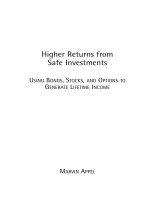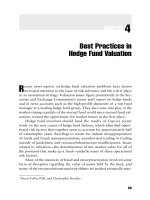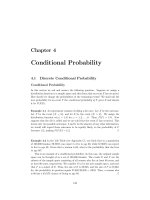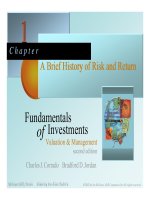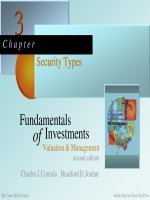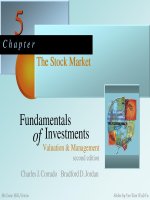Slides_Fundamentals of Investments - Chapter 4 doc
Bạn đang xem bản rút gọn của tài liệu. Xem và tải ngay bản đầy đủ của tài liệu tại đây (2.07 MB, 40 trang )
4
4
C h a p t e r
Mutual FundsMutual Funds
second edition
Fundamentals
of
Investments
Valuation & Management
Charles J. Corrado Bradford D.Jordan
McGraw Hill / Irwin Slides by Yee-Tien
(Ted) Fu
© 2002 by The McGraw-Hill Companies, Inc. All rights reserved.
McGraw Hill / Irwin
4 - 2
Mutual Funds
Our goal in this chapter is to
understand the different types of
mutual funds, their risks, and returns.
Goal
Investors added $363 billion in net new funds
to mutual funds in 1999, and by the end of the
year, mutual fund assets totaled $6.85 trillion.
These were estimated to be owned by
83 million Americans.
© 2002 by The McGraw-Hill Companies, Inc. All rights reserved.
McGraw Hill / Irwin
4 - 3
Mutual Funds
Mutual funds are simply a means of combining
or pooling the funds of a large group of
investors.
The buy and sell decisions for the resulting
pool are then made by a fund manager, who is
compensated for the service provided.
Like commercial banks and life insurance
companies, mutual funds are a form of
financial intermediary.
© 2002 by The McGraw-Hill Companies, Inc. All rights reserved.
McGraw Hill / Irwin
4 - 4
Investment Companies and Fund Types
Investment company
A business that specializes in pooling funds
from individual investors and investing them.
Closed-end fund
An investment company with a fixed
number of shares that are bought and sold
only in the open stock market.
Open-end fund
An investment company that stands ready to
buy and sell shares at any time.
Investment Companies and Fund Types
4 -
5
@2002 by the McGraw-
Hill Companies Inc.All rights reserved.
McGraw Hill / Irwin
© 2002 by The McGraw-Hill Companies, Inc. All rights reserved.
McGraw Hill / Irwin
4 - 6
Investment Companies and Fund Types
Shares in an open-end fund are worth their
NAV, because the fund stands ready to redeem
their shares at any time.
In contrast, the shares of closed-end funds may
or may not be equal to their NAV.
Net asset value
The value of the assets held by a mutual
fund, divided by the number of shares.
Abbreviated NAV.
© 2002 by The McGraw-Hill Companies, Inc. All rights reserved.
McGraw Hill / Irwin
4 - 7
Work the Web
For mutual fund facts and figures,
visit:
© 2002 by The McGraw-Hill Companies, Inc. All rights reserved.
McGraw Hill / Irwin
4 - 8
Mutual Fund Operations
Organization and Creation
A mutual fund is simply a corporation. It is
owned by shareholders, who elect a board of
directors.
Most mutual funds are created by investment
advisory firms (such as Fidelity Investments),
or brokerage firms with investment advisory
operations (such as Merrill Lynch).
These firms wish to manage the funds to earn
fees.
© 2002 by The McGraw-Hill Companies, Inc. All rights reserved.
McGraw Hill / Irwin
4 - 9
Work the Web
All the major fund families have
websites. Try, for example:
© 2002 by The McGraw-Hill Companies, Inc. All rights reserved.
McGraw Hill / Irwin
4 - 10
Mutual Fund Operations
Taxation of Investment Companies
An investment company that
c holds almost all its assets as investments in stocks,
bonds, and other securities,
d uses no more than 5% of its assets when acquiring
a particular security, and
e passes through all realized investment income to
fund shareholders,
is treated as a “regulated investment company”
for tax purposes and does not need to pay taxes
on its investment income.
© 2002 by The McGraw-Hill Companies, Inc. All rights reserved.
McGraw Hill / Irwin
4 - 11
Mutual Fund Operations
The Fund Prospectus and Annual Report
Mutual funds are required by law to supply a
prospectus to any investor who wishes to
purchase shares.
Mutual funds must also provide an annual
report to their shareholders.
© 2002 by The McGraw-Hill Companies, Inc. All rights reserved.
McGraw Hill / Irwin
4 - 12
Mutual Fund Costs and Fees
Types of Expenses and Fees
c Sales charges or “loads.” Front-end loads are
charges levied on purchases, while back-end
loads are charges levied on redemptions.
d 12b-1 fees. SEC Rule 12b-1 allows funds to
spend up to 1% of fund assets annually to
cover distribution and marketing costs.
e Management fees. Usually based on fund size,
performance, etc.
© 2002 by The McGraw-Hill Companies, Inc. All rights reserved.
McGraw Hill / Irwin
4 - 13
Mutual Fund Costs and Fees
Types of Expenses and Fees …continued
f Trading costs. This is related to the fund’s
turnover.
© 2002 by The McGraw-Hill Companies, Inc. All rights reserved.
McGraw Hill / Irwin
4 - 14
Mutual Fund Costs and Fees
Expense Reporting
Mutual funds are required to report expenses
in a fairly standardized way in the prospectus.
c Shareholder transaction expenses - loads and
deferred sales charges.
d Fund operating expenses - management and 12b-1
fees, legal, accounting, and reporting costs,
director fees.
e Hypothetical example showing the total expense
you would pay over time per $10,000 invested.
Mutual Fund
Costs & Fees
4 -
15
McGraw Hill / Irwin
© 2002 by The McGraw-Hill Companies, Inc. All rights reserved.
McGraw Hill / Irwin
4 - 16
Work the Web
Prospectuses are increasingly available
online. To see some examples, visit:
To see a fund that really discloses
information, try:
Check out the “plain language” risk
disclosure!
© 2002 by The McGraw-Hill Companies, Inc. All rights reserved.
McGraw Hill / Irwin
4 - 17
Mutual Fund Costs and Fees
Why Pay Loads and Fees?
You may want a fund run by a particular
manager, and all such funds are load funds.
You want a specialized type of fund. Loads
and fees for such funds tend to be higher as
there is little competition among them.
© 2002 by The McGraw-Hill Companies, Inc. All rights reserved.
McGraw Hill / Irwin
4 - 18
Short-Term Funds
Short-term funds are collectively known as
money market mutual funds, or MMMFs.
MMMFs always maintain a $1 net asset value
to make them resemble bank accounts.
Depending on the type of securities purchased,
MMMFs can be either taxable or tax-exempt.
Money market mutual fund
A mutual fund specializing in money market
instruments.
© 2002 by The McGraw-Hill Companies, Inc. All rights reserved.
McGraw Hill / Irwin
4 - 19
Short-Term Funds
Most banks offer what are called “money
market” deposit accounts, or MMDAs, which
are much like MMMFs.
The distinction is that a bank money market
account is a bank deposit and offers FDIC
protection.
© 2002 by The McGraw-Hill Companies, Inc. All rights reserved.
McGraw Hill / Irwin
4 - 20
Work the Web
For information on thousands of
funds, including MMMFs, visit:
© 2002 by The McGraw-Hill Companies, Inc. All rights reserved.
McGraw Hill / Irwin
4 - 21
Long-Term Funds
A fund’s objective is the major determinant of
the fund type.
Historically, mutual funds were classified as
stock, bond, or income funds. However, it is
becoming increasingly difficult to do so.
Stock, bond,
or income?
© 2002 by The McGraw-Hill Companies, Inc. All rights reserved.
McGraw Hill / Irwin
4 - 22
Stock Funds
Some stock funds trade off capital appreciation
and dividend income.
Î Capital appreciation, growth, growth and income,
equity income.
Some stock funds focus on companies in a
particular size range.
Î Small company, midcap.
Some fund groups invest internationally.
Î Global, international, region, country, emerging
markets.
© 2002 by The McGraw-Hill Companies, Inc. All rights reserved.
McGraw Hill / Irwin
4 - 23
Stock Funds
Sector funds specialize in specific sectors of
the economy.
Other fund types include index funds, social
conscience funds, and tax-managed funds.
© 2002 by The McGraw-Hill Companies, Inc. All rights reserved.
McGraw Hill / Irwin
4 - 24
Bond Funds
Bond funds may be distinguished by their
c maturity range , d credit quality,
e taxability, f bond type, and g issuing
country.
Bond fund types include short-term and
intermediate-term funds, general funds, high-
yield funds, mortgage funds, world funds,
insured funds, single-state municipal funds.
© 2002 by The McGraw-Hill Companies, Inc. All rights reserved.
McGraw Hill / Irwin
4 - 25
Stock and Bond Funds
Funds that do not invest exclusively in either
stocks or bonds are often called “blended” or
“hybrid” funds.
Examples include balanced funds, asset
allocation funds, convertible funds, income
funds.
